| Article ID | Journal | Published Year | Pages | File Type |
|---|---|---|---|---|
| 2790698 | Zoologischer Anzeiger - A Journal of Comparative Zoology | 2013 | 12 Pages |
The functional morphology of the mandible of gammaridean crustaceans is not yet fully understood. The origin of the structures at the mandibular gnathal edge, including incisor process, lacinia mobilis and molar process, is likewise still under dispute. Also functional aspects have not been considered sufficiently. Direct observations of the movements and interactions of the mandibles and their structures in living animals are almost impossible due to the topological situation of the mouthparts covering each other. We investigated the mandibles of six gammarideans, using scanning electron microscopy, aiming at a better understanding of the functional requirements and the moving capabilities of the mandibular structures and their limitations. Based on this we also applied computerized 3D modelling. One specific feature observed is a proximal outgrowth at the laciniae mobiles, which acts, in accord with the adjacent incisor process, as a switch to flip the lacinia mobilis into a downward and upward position, and with the incisor process of the opposing mandible clicking the switch – a rarely observed, if not the first, report of an actively used switch in nature. The entire action of right and left mandibles during the feeding act explains the asymmetrical morphology of the associate structures at the mandibular coxal ‘gnathal’ edges of gammarideans, possibly also of other malacostracans, at least those sharing a lacinia mobilis. This also serves as an example to uncover the multi-functionality and complexity of many morphological structures in crustaceans and arthropods more generally.
